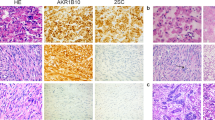Abstract
Purpose
Molecular studies have demonstrated a wide range of gene expression variations in uterine leiomyoma. The rat sarcoma virus/rapidly accelerated fibrosarcoma/mitogen-activated protein kinase (RAS/RAF/MAPK) is the crucial cellular pathway in transmitting external signals into nucleus. Deregulation of this pathway contributes to excessive cell proliferation and tumorigenesis. The present study aims to investigate the expression profile of the K-Ras transcripts in tissue samples from patients with leiomyoma.
Methods
The patients were leiomyoma cases who had no mutation in mediator complex subunit 12 (MED12) gene. A quantitative approach has been applied to determine the difference in the expression of the 2 main K-Ras messenger RNA (mRNA) variants. The comparison between gene expression levels in leiomyoma and normal myometrium group was performed using relative expression software tool.
Results
The expression of K-Ras4B gene was upregulated in leiomyoma group (P =.016), suggesting the involvement of K-Ras4B in the disease pathogenesis. Pairwise comparison of the K-Ras4B expression between each leiomyoma tissue and its matched adjacent normal myometrium revealed gene upregulation in 68% of the cases. The expression of K-Ras4A mRNA was relatively upregulated in leiomyoma group (P =.030). In addition, the mean expression of K-Ras4A gene in leiomyoma tissues relative to normal samples was 4.475 (95% confidence interval: 0.10-20.42; standard error: 0.53-12.67). In total, 58% of the cases showed more than 2-fold increase in K-Ras4A gene expression.
Conclusion
Our results demonstrated increased expression of both K-Ras mRNA splicing variants in leiomyoma tissue. However, the ultimate result of KRAS expression on leiomyoma development depends on the overall KRAS isoform balance and, consequently, on activated signaling pathways.
Similar content being viewed by others
References
Lippman SA, Warner M, Samuels S, Olive D, Vercellini P, Eskenazi B. Uterine fibroids and gynecologic pain symptoms in a population-based study. Fertil Steril. 2003;80(6):1488–1494.
Ono M, Qiang W, Serna VA, et al. Role of stem cells in human uterine leiomyoma growth. PloS One. 2012;7(5):e36935. doi:10.1371/journal.pone.0036935.
Wise LA, Palmer JR, Harlow BL, et al. Reproductive factors, hormonal contraception, and risk of uterine leiomyomata in African-American women: a prospective study. Am J Epidemiol. 2004;159(2):113–123.
Maruo T, Ohara N, Yoshida S, et al. Translational research with progesterone receptor modulator motivated by the use of levonorgestrel-releasing intrauterine system. Contraception. 2010;82(5):435–441. doi:10.1016/j.contraception.2010.05.006.
Morkel M, Riemer P, Blaker H, Sers C. Similar but different: distinct roles for KRAS and BRAF oncogenes in colorectal cancer development and therapy resistance. Oncotarget. 2015;6(25):20785–20800. doi:10.18632/oncotarget.4750.
Molina JR, Adjei AA. The Ras/Raf/MAPK pathway. J Thorac Oncol. 2006;1(1):7–9.
Shahrabi-Farahani M, Shahbazi S, Mahdian R, Amini-Moghaddam S. K-Ras 4A transcript variant is up-regulated in eutopic endometrium of endometriosis patients during proliferative phase of menstrual cycle. Arch Gynecol Obstetr. 2015;292(1):225–229. doi:10.1007/s00404-014-3596-7.
Voice JK, Klemke RL, Le A, Jackson JH. Four human Ras homologs differ in their abilities to activate Raf-1, induce transformation, and stimulate cell motility. J Biol Chem. 1999;274(24):17164–17170.
Plowman SJ, Williamson DJ, O’Sullivan MJ, et al. While K-Ras is essential for mouse development, expression of the K-Ras 4A splice variant is dispensable. Mol Cell Biol. 2003;23(24):9245–9250.
Shahbazi S, Fatahi N, Amini-Moghaddam S. Somatic mutational analysis of MED12 exon 2 in uterine leiomyomas of Iranian women. Am J Cancer Res. 2015;5(8):2441–2446.
Almeida TA, Quispe-Ricalde A, Montes de Oca F, Foronda P, Hernandez MM. A high-throughput open-array qPCR gene panel to identify housekeeping genes suitable for myometrium and leiomyoma expression analysis. Gynecol Oncol. 2014;134(1):138–143. doi:10.1016/j.ygyno.2014.04.012.
Ciarmela P, Islam MS, Reis FM, et al. Growth factors and myometrium: biological effects in uterine fibroid and possible clinical implications. Hum Reprod Update. 2011;17(6):772–790. doi:10.1093/humupd/dmr031.
Yeh J, Rein M, Nowak R. Presence of messenger ribonucleic acid for epidermal growth factor (EGF) and EGF receptor demonstrable in monolayer cell cultures of myometria and leiomyomata. Fertil Steril. 1991;56(5):997–1000.
Harrison-Woolrych ML, Charnock-Jones DS, Smith SK. Quantification of messenger ribonucleic acid for epidermal growth factor in human myometrium and leiomyomata using reverse transcriptase polymerase chain reaction. J Clin Endocrinol Metab. 1994;78(5):1179–1184. doi:10.1210/jcem.78.5.8175976.
Fotiou SK, Tserkezoglou AJ, Mahera H, et al. Chromosome aberrations and expression of Ras and myc oncogenes in leiomyomas and a leiomyosarcoma of the uterus. Eur J Gynaecol Oncol. 1992;13(4):340–345.
Hall KL, Teneriello MG, Taylor RR, et al. Analysis of Ki-ras, p53, and MDM2 genes in uterine leiomyomas and leiomyosarcomas. Gynecol Oncol. 1997;65(2):330–335. doi:10.1006/gyno.1997.4653.
Jancik S, Drabek J, Radzioch D, Hajduch M. Clinical relevance of KRAS in human cancers. J Biomed Biotechnol. 2010;2010:150960. doi:10.1155/2010/150960.
Plowman SJ, Berry RL, Bader SA, et al. K-Ras 4A and 4B are co-expressed widely in human tissues, and their ratio is altered in sporadic colorectal cancer. J Exp Clin Cancer Res. 2006;25(2):259–267.
Nussinov R, Tsai CJ, Chakrabarti M, Jang H. A new view of Ras isoforms in cancers. Cancer Res. 2016;76(1):18–23. doi:10.1158/0008-5472.CAN-15-1536.
Tsai FD, Lopes MS, Zhou M, et al. K-Ras4A splice variant is widely expressed in cancer and uses a hybrid membrane-targeting motif. Proc Natl Acad Sci U S A. 2015;112(3):779–784. doi:10.1073/pnas.1412811112.
Brooks DG, James RM, Patek CE, Williamson J, Arends MJ. Mutant K-Ras enhances apoptosis in embryonic stem cells in combination with DNA damage and is associated with increased levels of p19(ARF). Oncogene. 2001;20(17):2144–2152. doi:10.1038/sj.onc.1204309.
James RM, Arends MJ, Plowman SJ, et al. K-Ras proto-oncogene exhibits tumor suppressor activity as its absence promotes tumorigenesis in murine teratomas. Mol Cancer Res. 2003;1(11):820–825.
Cox AD, Der CJ. The dark side of Ras: regulation of apoptosis. Oncogene. 2003;22(56):8999–9006. doi:10.1038/sj.onc.1207111.
Abubaker J, Bavi P, Al-Haqawi W, et al. Prognostic significance of alterations in KRAS isoforms KRAS-4A/4B and KRAS mutations in colorectal carcinoma. J Pathol. 2009;219(4):435–445. doi:10.1002/path.2625.
Author information
Authors and Affiliations
Corresponding author
Rights and permissions
About this article
Cite this article
Zolfaghari, N., Shahbazi, S., Torfeh, M. et al. Identification of Differentially Expressed K-Ras Transcript Variants in Patients With Leiomyoma. Reprod. Sci. 24, 1438–1443 (2017). https://doi.org/10.1177/1933719116689596
Published:
Issue Date:
DOI: https://doi.org/10.1177/1933719116689596




